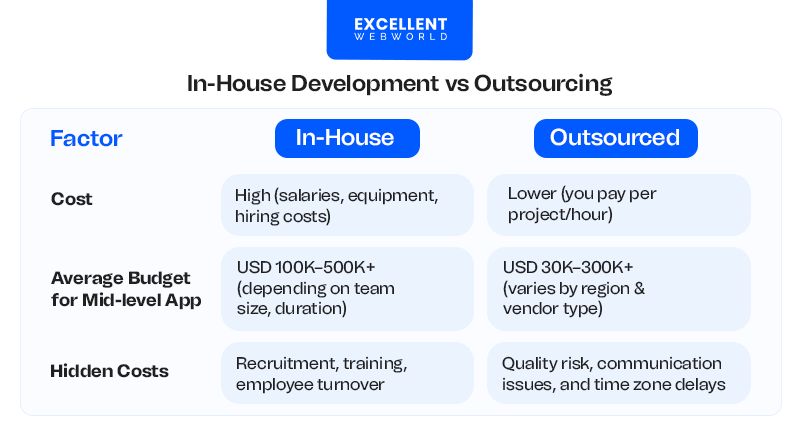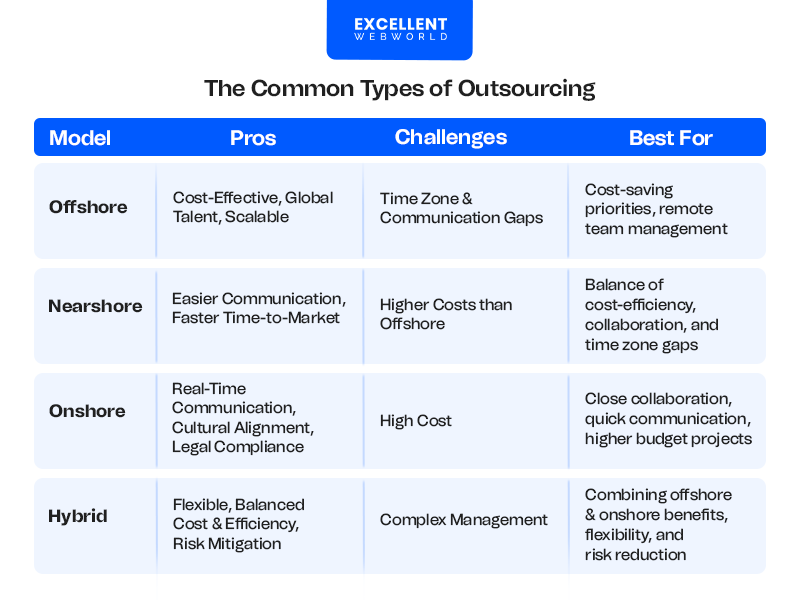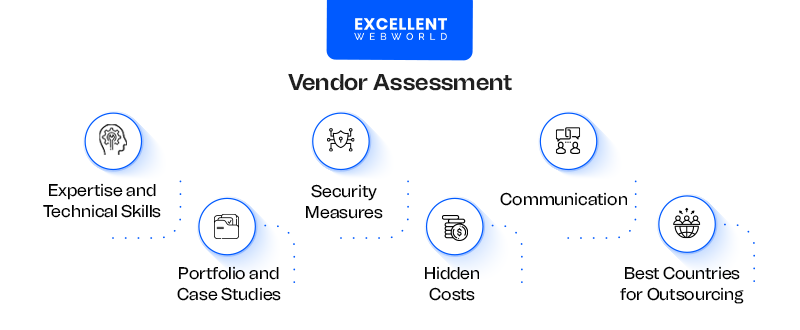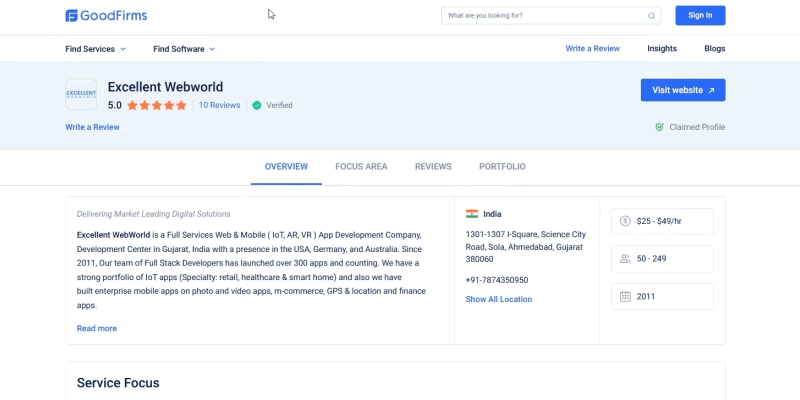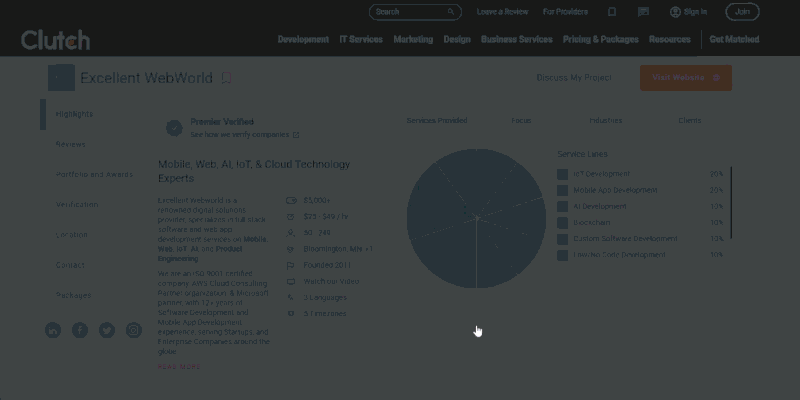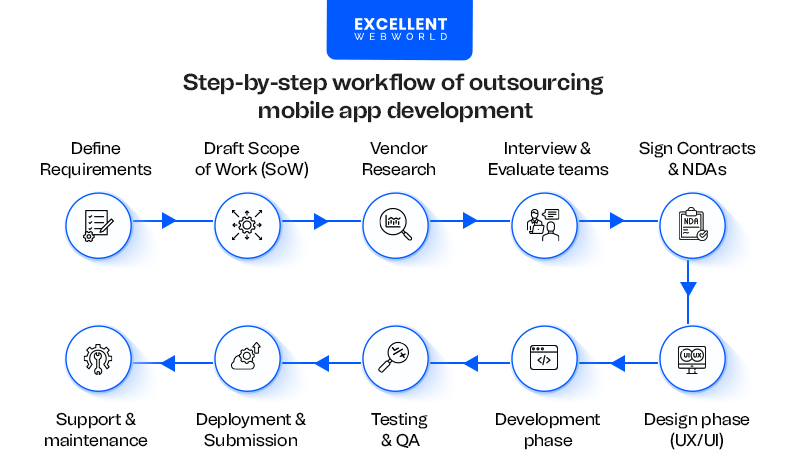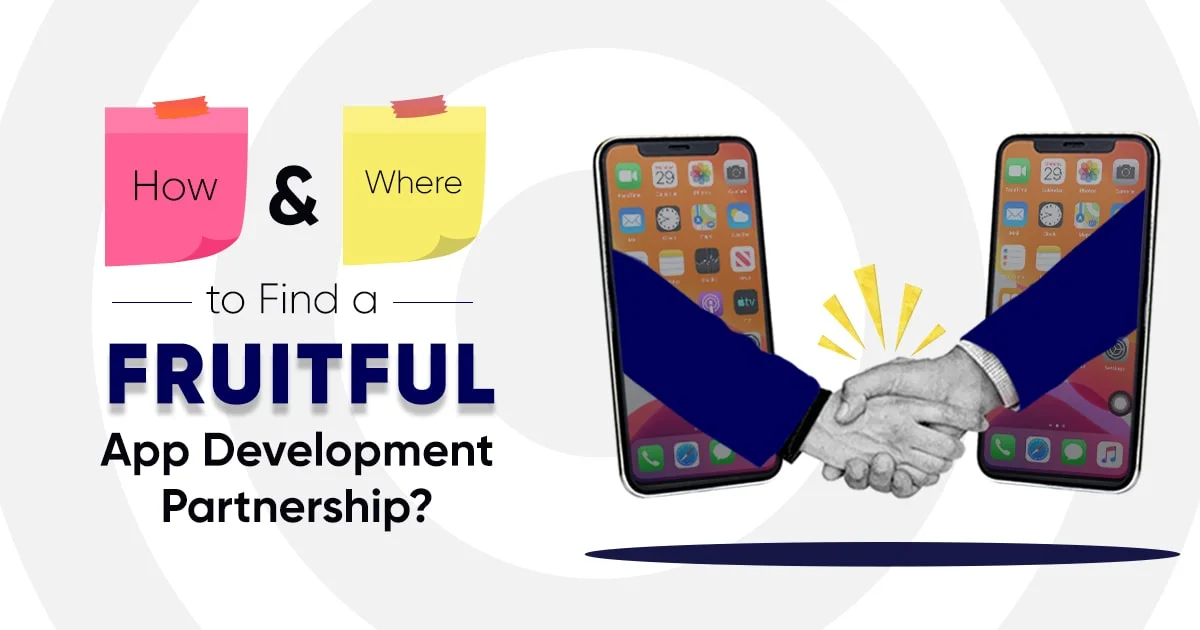Are you struggling to find skilled professionals? Is your project plagued by delays and complexities of the development process? Outsourcing is the best approach for your project! Choosing to outsource mobile app development can help you overcome these challenges.
Nowadays, companies are turning to outsourcing to stay competitive and agile in the market. Outsourced app development teams provide innovative software solutions at lower prices. Also, you can tap into regions where skilled workers are available for less and develop high-quality products.
With the increasing mobile app uses, outsourcing mobile app development has become a good business strategy driven by key market trends and cost efficiency. This approach helps companies to scale faster, reduce costs, and stay agile. By addressing common concerns like communication and quality, outsourcing allows companies to focus on growth while ensuring high-quality mobile app development.
The article will cover all the essential aspects regarding the benefits of outsourcing development companies, how you can find the best outsourcing company in India for your software solution, and how much it costs to outsource mobile app development to India.
Why Businesses Choose to Outsource Mobile App Development
Developing a mobile app in-house may not always be the most cost-effective or efficient solution. Many business leaders are outsourcing for mobile app development due to its numerous advantages.
The global market for development outsourcing is expected to be 591.24 billion USD in 2025. One of the key reasons why the outsourcing market is growing is the overarching benefits that this approach offers. Outsourcing helps you focus on how to stand out in the marketplace and reduces overall cost.
Now, let’s explore the key factors in choosing the right outsourcing model for mobile app development for startups and businesses and why it is so important.
Choosing the Right Outsourcing Model for Mobile App Development
There are multiple options available for outsourcing mobile app development, and you need to choose the right model to meet your business goals. Each model has its advantages and challenges.
Here’s an overview of the key outsourcing application development models to help you make an informed decision:
1. Offshore Outsourcing
Offshore outsourcing involves hiring development teams in distant countries with a time zone difference of more than 4 hours, often in regions like India or Eastern Europe. The offshore outsourcing app offers a defined web development team structure to build custom solutions.
Pros:
Challenges:
Offshore outsourcing apps are best suited for businesses with a large budget that prioritize cost-saving and are prepared to manage remote development teams effectively.
2. Nearshore Outsourcing
Outsourcing apps to development teams in nearby countries is called nearshore outsourcing. Nearshore Software Development Services make this process easier by improving collaboration and speeding up delivery.
Pros:
Challenges:
Nearshore outsourcing is ideal for businesses seeking a balance between cost and less difference in time zones.
See Also: Nearshore Software Development
3. Onshore Outsourcing
Onshore outsourcing apps means hiring development teams within the same country or region. So, there are minimal or no time zone differences.
Pros:
Challenges:
Onshore outsourcing works well for projects requiring close collaboration, rapid communication, minimal cultural differences, and where budget is not the primary concern.
4. Hybrid Outsourcing
Hybrid outsourcing combines different models, such as a blend of offshore and onshore teams, to maximize both benefits.
Pros:
Challenges:
Hybrid outsourcing is ideal for large-scale projects that require a mix of cost-effectiveness and close collaboration on certain aspects.
How to Choose the Right Outsourcing Model
While choosing an outsourcing model, consider the following factors:
How to Find the Right Mobile App Development Outsourcing Company
Hiring the right mobile app development outsourcing company is crucial when outsourcing mobile app development. A reputable company will have a team of skilled developers, a proven track record, and a strong reputation in the industry. They will also know the latest technologies, tools, and methodologies to develop high-quality software solutions.
However, finding the right application development outsourcing company can be daunting, especially if you’re unfamiliar with the process. This section will provide a step-by-step guide on hiring the best outsource mobile app development company.
Here are some key criteria for choosing an outsourcing partner
1. Expertise and Technical Skills
The primary factor while choosing a mobile app development outsourcing company is their expertise and experience. This includes their proficiency in the latest technologies, programming languages (e.g., Swift, Kotlin, React Native), and the ability to build software solutions. An app development vendor with a proven track record in mobile app development is essential.
2. Portfolio and Case Studies
The company’s strong portfolio, or collection of case studies, provides insight into the experience and quality of their work. Check companies’ previous mobile app development projects that are similar to yours.
Additionally, read client reviews on platforms like GoodFirms and Clutch to ensure the quality of work. Evaluate the company’s communication skills.
3. Security Measures
Data security is crucial while outsource mobile app development. Your chosen mobile app development outsourcing company should stick to industry-standard security practices and protocols. Ensure the development company uses encryption, secure coding practices, and data protection regulations (such as GDPR, HIPAA, etc.) to protect sensitive information.
Here are some key points you should avoid while outsourcing
1. Hidden Costs
One of the most common risks in outsourcing is unexpected costs that arise in the middle of the project. Ensure that all costs, including development, testing, maintenance, and post-launch support, are clearly outlined in the initial agreement. If a company is unwilling to provide detailed cost breakdowns or hides fees, it could indicate potential issues down the line.
2. Poor Communication
Communication is key to a successful outsourcing partnership. If the company is slow to respond, vague in their answers, or challenging to reach, it can signal poor project management. Ensure the company maintains transparent, open, consistent communication throughout development. A lack of transparency or delayed responses can cause project setbacks and frustration.
3. Lack of Documentation
A reputable mobile app outsourcing company should be able to provide comprehensive documentation at every stage of the project, which includes planning, coding standards, and user manuals. If a company cannot deliver clear documentation or provide updates on project progress, it can lead to misunderstandings and missed deadlines.
But how to evaluate? Well, before committing to a mobile app outsourcing company, use this checklist to assess their suitability:
After exploring all the aspects, like what should not be and what should be considered, while outsourcing.
Certain regions are known for their competitive pricing, technical expertise, and strong developer talent pools when outsourcing mobile app development. But you have to choose best countries for outsourcing mobile application development.
Here are some of the best countries for outsourcing.
| Country | Strengths | Key Benefits |
|---|---|---|
| India | Cost-effective services, a Large pool of skilled developers, and Trusted outsourcing companies | Affordable app development pricing, High-quality mobile app solutions, Strong IT infrastructure |
| Ukraine | High technical proficiency, Skilled in modern technologies and frameworks | Advanced technical expertise, Competitive pricing, Strong engineering talent |
| Poland | Growing reputation in software development, Good for outsourcing app developers | Skilled workforce, Strong European Union standards, High-quality app development |
1. India
India is one of the leading destinations for outsourcing mobile app development. Outsourcing in india is known for its cost-effective services and a large pool of skilled developers. India is home to many trusted mobile app outsourcing companies.
2. Ukraine
Ukraine offers a high level of technical proficiency, with many developers skilled in modern technologies and mobile app development frameworks.
3. Poland
Poland has a growing reputation for its talented software development outsourcing community, particularly in mobile app development.
Cost Breakdown: How Much Does Outsourced Mobile App Development Cost?
Outsourcing mobile app development can significantly reduce costs, but understanding the exact cost structure is crucial for effective budget planning. It’s important to understand that the overall cost is affected by the components of hiring an outsourcing development team.
In this section, we’ll discuss the various factors contributing to the cost of hiring a mobile app outsourcing company. Such as the cost of hiring developers on the basis of hourly rates, the team’s size and experience, the project’s scope and complexity, and more.
Key Cost Factors in Outsourcing Mobile App Development
The cost of outsourcing mobile app development is influenced by several factors, such as:
| Cost Factor | Description |
|---|---|
| Feature Complexity | More complex features, such as AI implementation, GPS, and in-app purchases, increase development time and cost. |
| App Platform | Android app development outsourcing tends to be less expensive than outsource iOS app development due to the diverse range of devices for Android. |
| AI Integration | Integrating AI/ML adds time and cost due to the specialized expertise required. |
| Design & UX/UI | Custom designs and seamless user experiences increase design costs. |
| App Maintenance | Ongoing maintenance costs for updates, bug fixes, and optimizations. |
| Development Team Location | Costs vary greatly based on where the development team is located. |
Cost Comparison by Outsourcing Destination
The cost of outsourcing mobile app development differs significantly depending on the location of the development team. Here’s a comparison of the average hourly rates and overall project costs across several regions.
| Outsourcing Location | Average Hourly Rate | Development Cost (MVP) | Development Cost (Full-Scale App) |
|---|---|---|---|
| India | 20 – 30 USD | 20k – 25k USD | 35k – 70k USD |
| Poland | 30 – 60 USD | 25k – 40k USD | 50k – 100k USD |
| Ukraine | 25 – 50 USD | 38k – 35k USD | 45k – 85k USD |
| USA | 100 – 200 USD | 50k – 150k USD | 150k – 300k USD |
Additional Costs to Consider
MVP vs. Full-Scale App Development Costs
When outsourcing mobile app development, one of the major decisions you’ll face is whether to build a Minimum Viable Product (MVP) or proceed with a full-scale app right away.
| Development Type | Cost | Pros | Cons |
|---|---|---|---|
| MVP Development | 18k – 50k+ USD (depending on complexity and location) | Faster to Market, Cost-Effective, Easy to Iterate based on user feedback | Limited Features, May Lack Advanced Functionality/Integrations |
| Full-Scale App Development | 50k – 300k+ USD (depending on complexity) | Complete Product with all features, Ready for Market | Higher Upfront Investment, Longer Time to Market |
MVP Development
An MVP is a simplified app version that includes only the essential features required to launch and test the concept. With MVP development services you can gather early feedback, validate your idea, and minimize risk before committing to full-scale development.
Full-Scale App Development
A full-scale app includes all features, designs, and functionality required for a product. This approach is suitable if you’re ready to outsource mobile application development.
Hidden Costs and How to Avoid Them
While you may have an initial development estimate, hidden costs can increase the overall budget if you’re not careful. Here’s how to avoid common challenges:
1. Unclear Project Scope
Additional work or changes may result in extra charges without a clear project scope. Before developing, always define the app’s features, timeline, and expectations.
2. Post-Launch Costs
The initial budget may not include the cost for ongoing maintenance, bug fixes, and updates. Ensure that the maintenance costs are outlined from the beginning. Check out more details on app maintenance costs to plan for post-launch expenses.
3. Third-Party Services
Integrating third-party services like payment gateways, chatbots, or data analytics might incur additional fees. Be sure to ask the outsourcing company to include these costs in the proposal.
4. Quality Assurance and Testing
If your app requires extensive testing, it can be an overlooked cost. Always allocate a portion of the budget to comprehensive QA, especially if you’re developing a more complex app.
5. Updates and App Store Fees
Ongoing updates are essential for keeping your app functional and compatible with newer devices. Listing your app on platforms like the Apple App Store or Google Play Store also has costs.
As you see, the cost of outsource mobile development depends on multiple factors, and it’s crucial to choose which one is suitable for your business. But the question that arises here is how to outsource app development.
The Step-by-Step Process of Outsourcing Mobile App Development
Choosing to outsource mobile app development is an effective way to access specialized expertise while controlling your project costs. By following a structured process, you can ensure that the project runs smoothly and meets your expectations. In this guide, we’ll walk you through a simple three-step process to outsource application development successfully.
1. Define Your Requirements & Find the Right Vendor
The first step is to outline your project requirements and define what you need from your mobile app. This includes identifying the app’s core features, design preferences, target audience, and platform (iOS, Android, or cross-platform). Once you have a clear understanding of your project, start looking for skilled mobile developers or web app development outsourcing services.
Key Considerations
Once you’ve identified potential vendors, engage with them to assess their expertise, communication practices, and past project successes.
For more details on the mobile app development process, check out our guide on the mobile app development process.
2. Collaborate and Plan the Development Process
After selecting your outsourcing service provider, the next step is to collaborate and create a detailed development plan. This step is crucial for setting clear expectations, timelines, and milestones for the project. You and the mobile development outsourcing team need to work together to finalize app features, design, user experience (UX), and any third-party integrations.
Here are important tasks you should consider
Effective planning will ensure that both teams are aligned on the project’s goals, timeline, and deliverables.
3. Testing, Deployment & Post-Launch Support
When the outsourced mobile application development is completed, rigorous testing is essential to ensure the app is bug-free, responsive, and secure. Mobile app quality assurance should be part of the process, with your outsourcing partner conducting multiple rounds of testing.
Here are the key activities you need to perform:
This phase ensures the app is bug-free, meets all quality standards, and is ready for use by the public. It also sets up a foundation for future updates and improvements
Tips to Manage Mobile App Development Outsourcing
Outsourcing mobile app development requires effective communication, clear expectations, and the right tools. To ensure success, follow these best practices and leverage essential software for seamless project management.
Best Practices for Outsourcing Mobile Application Development Partnerships:
Essential Tools for Outsourced App Development:
Why Trust Excellent Webworld for Outsourcing Mobile App Development?
The above article should have helped you understand the benefits of outsourcing mobile app development and how to choose a mobile app outsourcing company. However, if you need assistance, especially with mobile app development in the entertainment, car rental, healthcare, eCcommerce, and logistics industries, Excellent Webworld is here to help.
With more than 13 years of experience and 900+ successful projects delivered, our experts are adept at designing mobile apps. Get customized development solutions consulting services from our experts.
We design solutions that meet your business-specific requirements and guarantee improved business. Contact one of the top app design companies to build custom app solutions.
FAQs on Outsourcing Mobile App Development
Outsourcing mobile app development is more cost-effective and flexible in the long term. Also, you don’t need to invest in experts in new technologies or train new skills. Contrary to in-house, providing better control, outsourcing is more beneficial in terms of ROI.
Industries such as healthcare, financial services, eCommerce, food or grocery ordering, education, and more benefit from outsourcing mobile app development. It reduces cost and quickly adapts to the market.
Establish clear communication protocols, set expectations using project management tools like Jira and Trello, and follow collaboration transparency. It can enhance the efficiency of the outsourced app development team.
You can choose various engagement models while outsourcing app development. Here are a few: fixed price, time and material, dedicated team, staff augmentation, and hybrid models.
Businesses can change the solution according to the market demand because of the flexibility in resource allocation and access to expertise. Additionally, overall cost-effectiveness allows maintaining the outsourced mobile apps.
Project management tools can make managing outsourced application development projects very easy. Tools like Jira and Trello will help you manage tasks, and for communication, go with Slack or Zoom, as they provide real-time discussion.
Ensure code quality while outsourcing mobile app development, implementing continuous integration and delivery, robust testing procedures, and smooth communication.
Different locations offer different rates for outsourced app development. Outsource mobile app development in India and Eastern Europe to provide lower rates, while the USA and Western Europe are expensive.
Mobile application development outsourcing trends in 2025 include AI integration, technologies like AR/VR and IoT applications, and growing cross-platform and no-code platforms.

Article By
Mahil Jasani began his career as a developer and progressed to become the COO of Excellent Webworld. He uses his technical experience to tackle any challenge that arises in any department, be it development, management, operations, or finance.

